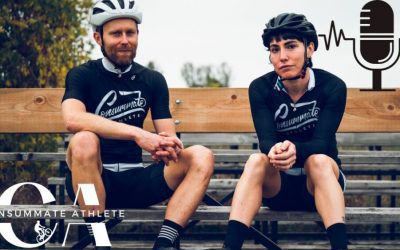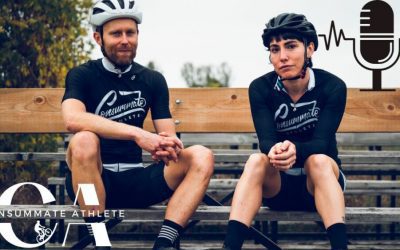Looking to start strength training? Want to be strong for anything? Well today’s guest, Robert Herbst, is a very successful powerlifter who is a great example of what Power-Lifting can do to create great health and the ability to jump into a variety of sports. NOW power-lifting might scare you off and make you think of massive men grunting in the weight room … all we are talking about here is a discipline of weight-lifting using 3 very common lifts–the Squat, Deadlift, Bench Press. Now you can compete in power-lifting but many people use the techniques simply as their choice form of strength-training.
We talk a lot about strength training as a way to improve any type of endurance or adventure activity, but what about weight lifting in its own right?
Love the one quote from our guest today, “It Never hurts to be strong, and it never hurts to look good”
This Episode is brought to you by HEALTH-IQ a great insurance option for active people like you. They provide lower rates due to the better health cyclists and other active people enjoy. Please check it out and get covered!
Don’t forget to check out www.wideanglepodium.com for show info, other podcasts and to see if becoming a donating member of the network is for you.
Download on Itunes (subscribe & leave a review Please!)
Download Android / Stream / Listen online
Download and view on Wide-Angle-Podium Site
BIO
Robert Herbst is a power lifting champion. at 58 hes 18 time World Champion, 32 time National Champion, member of the AAU Strength Sports Hall of Fame and coach. He’s coached everyone from beginners to elite competitors. He’s here to share how to start out in powerlifting such as training for a first competition.
More About Robert:
In addition to that:
—Supervising drug testing at Olympics
—Lawyer in his other life
—coached hockey, soccer, little league… “It never hurts to be strong.”
—in summers, he’s out playing with the kids while the parents are in the bleachers (“And I squatted the night before!”)
—58 years old
—W8lifterUSA.com, where he pushes the message of sport and fitness for people of every age.
Tell us your story, how did you find weight-lifting ?
-Most Americans have tried to bench press
-Myth of getting ‘muscle bound’ is being re-cast
-Power lifting is a competitive sport too, but can do it for fitness
-Too small for football/hockey, small 100-lb freshman—after a collision with a teammate where teammate went flying and he stayed in place, Herbst decided to do something about it
-Was told to start lifting weights at lacrosse camp
–Started on the floor press at home vs a bench-press (didn’t have a bench)
-Wrestled in college
– (Had scoliosis and back pain, was told not to lift weights off the ground, thought ‘what if I encased my back in muscle’)
– Over the years, doctors have said to him that fitness coaches are way ahead of them in a lot of ways
=> Deadlifts help everything (surprising applications in almost every sport, i.e archery in the Olympics, baseball)
=> Strength training is applicable to every sport—make muscles less tired (i.e cyclists’ back under tension, and working hips/back/upper back will make you stronger on the bike, have more endurance, keep better form and posture, which would decrease pain)
=> Difference weight lifting vs. Power lifting ?
“It’s all weight training.” Different events are contested in Olympic (i.e clean and jerk) while power lifting is squat, bench press and deadlifts
Olympic lifts are more ballistic/technique driven—lighter weight, quickly. As you get older, more prone to injuries
Power lifting is less technique, can be done slower
Power lifting weights are heavier
Power lifts work muscles Olympic don’t—all major muscle groups, in a more controlled fashion (add in things like bent over rows for training for back, lats, grip, forearms, biceps, core, abs, etc., and provides opposite of bench press)
=> Getting started
Farmers walk handles == grip strength
Reverse curls, wrist curls also help grip and forearms
Don’t waste time on ultra-light weights, do body weight to get started instead (pushups, pull ups, one leg squats, hanging from a bar)
Hard to motivate to lift weights when the base starting weight is just super low, so try to avoid embarrassment factor by being in shape before adding weight
TECHNIQUE! Strength will come
Never hurts to be strong, never hurts to look good
Really, really hard to get too big (don’t have the hormones, don’t have the pharmacist)
=> Why lift?
Be able to jump into anything. Improves cardio and strength
To be a consummate athlete, need to be able to do most of these key moves, i.e squats, and have grip strength
You can balance what you do with any sport and work in weight training
Olympics: swimmers going from pool to gym. Even top pros keep weights in schedule
Runners can work on strength to boost overall performance/avoid certain weaknesses
Power lifting moves challenge all muscles—don’t need to compete, but can compete with yourself
Success is very tangible in weight lifting (you lift it or you don’t)
Lifting a heavy weight is very satisfying
You get stronger out of the gym—recovery / response is where adaptations happen
-> What makes a good lifter
Herbst #1 thing is to stretch every AM (“I will be stretching on my last day.”)
Be satisfied with where you are — pushing yourself counts. “So many ways to get satisfaction from the sport”
Looking at things in context, i.e can’t be 100% all the time
Stay hydrated—a lot of lifters Robert sees are chronically dehydrated (Robert likes Hydrus, a non-caloric electrolyte additive)
-> equipment needed to start ?
– 1st thought is deck of cards (deck of cards of pushups will kick your ass. Pick a card, i.e a 5, and do 5 pushups. There’s 448 pushups in a deck)—great for vacation/traveling
– Power lifting bar with variety of plates (Olympic bars are thinner—you can use one to start, and won’t be an issue for regular people)
– Power rack for squats (basically a large rectangular cube with holes up the support to hold the bar at different heights)
– Bench for bench press (wide enough so shoulders are on the bench—Robert likes EliteFTS.com for equipment)
– Good shoe—not a runner shoe, a lifting shoe with slight heel for squats (some people even squat in work boots). Squishier soles will compress during heavy lift (Robert lifts in wrestling shoes with minimal sole)
– For heavier lifting, power lifting belt. As you lift, there are ways to use belt to improve technique (compression around spine offers more supports, teaches you to push abs for leverage). But to start, stay away from belt to build core strength and back strength at first.
=> getting started
– Build flexibility, start slow, focus on form. Put stress in appropriate places (i.e legs/hips vs lower back)
– Well-rounded program important. Should have a focus on core (not just crunches). Squatting or deadlifting, your abs are doing a lot of the work
– When in life do you do a sit-up motion, whereas how often do we make squat motion? (picking up baby, picking up groceries…) Mimic motions that will give you strength in the ranges where you need motion




